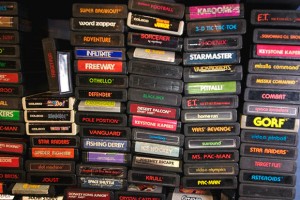The international academic journal Library Quarterly recently published my article tracing the history of gaming in libraries back to the 1850s. You can see the entire article in the publications area of my game lab, Because Play Matters. I wanted to offer a few highlights here about how public libraries have used games over the years.
Checkmate!
 It all started with chess. In 1854, the Mechanics’ Institute Library in San Francisco added a room for a chess club to meet. The chess club that started meeting there still meets today, and this makes it the oldest continually running chess club in the United States!
It all started with chess. In 1854, the Mechanics’ Institute Library in San Francisco added a room for a chess club to meet. The chess club that started meeting there still meets today, and this makes it the oldest continually running chess club in the United States!
I visited this library and chess club. Since I have studied games in libraries for years, I understood that I was stepping upon hallowed ground. I talked with the staff and helped them understand just how important their library and chess club room were in the history of gaming in libraries.
Gaming was also being used in libraries in the UK at this time, as some libraries were using billiards to bring people out of the pubs and into more reputable places. Many libraries existed for the moral betterment of society, so games were used to bring people in, so they could then engage with other library resources. This is not different from today; many libraries currently use games as a way to attract people to the library.
The Great Depression
The Great Depression created two new ways that libraries engaged with games. The first was through toy libraries; these were special libraries where patrons could check out games and toys to take home. While some of these were independent, some public libraries added collections of games and toys to help parents in those tough times.
Toy libraries are still active today, as you can see from this list. Many libraries continue this tradition and circulate digital games. A search in the St. Louis Public Library catalog unearths over 200 Xbox Games for checkout including recent titles like Madden NFL 25.
The second new way that libraries worked with games and puzzles back then was through contest support. Companies released puzzle-based contest for large amounts of cash. People out of work, desperate for some hope, rushed to libraries to do research.
Libraries found that information resources were being stolen or destroyed by people eager to reduce the pool of other correct entries. Some libraries chose to ban people who came to do puzzle research, while other libraries embraced the concept and put the reference works, open to the necessary pages, in glass display cases so that everyone could benefit.
This accurately represents gaming today–some libraries have chosen to ban gaming, while others have embraced it and made it part of their offerings.
Supporting a Recreational Society
As society became more engaged with recreation, many libraries adapted to the demands of a public seeking support for recreational media. Each time libraries changed, it caused an uproar. The move from non-fiction to introducing fiction in the library (GASP!) to the circulation of music (HORRORS!) to the availability of movies and TV shows through laserdisc, videotape, and DVD (YIKES!) to now the introduction of games (EEEK!) is a natural progression of the role that libraries play.
As interest in computers grew, libraries supported that interest. Many libraries had games available on computers as a way of helping people become comfortable with the technology in the late 1970s and early 1980s. Some libraries started circulating Atari cartridges and hosting Dungeons and Dragons clubs.
Video, Board Game Events
This trend has continued, and now many libraries are hosting regular video or board game events. Many libraries target teens as way of bringing them into the library. I helped the Fayetteville Free Public Library start a gaming event a few years ago that ran right after a computer class for senior citizens. I watched over the summer as local teens and senior citizens got to know each other around the game tables.
As libraries move from being places of consumption to places of creation, these makerspaces connect well into one future path for libraries–game design. There is a growing interest in libraries facilitating game design programs. I’m looking to support that by taking my Game Designers Guild model (a community group that makes games for good for Upstate New York non-profit  groups) and helping libraries start local chapters.
groups) and helping libraries start local chapters.
There is much more to the story. School libraries, academic libraries, and gaming collections are all part of the last 150 years of gaming in libraries. You’ll find more about this, as well as the resources from where the information from this article was taken: Playing in the Past: A History of Games, Toys, and Puzzles in North American Libraries.
If you want to learn more about gaming in libraries, you can take in the MOOC-Before-There-Were-MOOCs that I ran via YouTube in 2009, or see the numerous articles I’ve written on that topic.
Game on!
Thoughts on the role of games and play in libraries? Share in the comments below.


